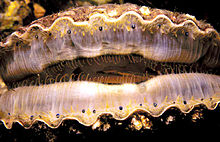Eye
![]()
This article describes the organ; for other meanings, see Eye (disambiguation).
The eye (ancient Greek ὀφθαλμός ophthalmós or ὤψ ōps, Latin oculus) is a sensory organ for the perception of light stimuli. It is part of the visual system and enables vision. Stimuli are received by photoreceptors, light-sensitive nerve cells whose state of excitation is altered by the different wavelengths of electromagnetic radiation from the visible spectrum. In vertebrates, the nerve impulses are processed starting in the retina and travel via the optic nerve pathways to the visual centre of the brain, where they are finally processed into visual perception.
The eyes of animals sometimes differ considerably in structure and functionality. Their performance is closely adapted to the requirements for the respective organism. The number of eyes is also an evolutionary result of the living conditions. Some animals, whose orientation is less determined by visual impressions, only need a coarse differentiation of light and dark, others need contrast and movement patterns. Higher developed eyes serve the contrast-rich image perception, whose quality increases with the ability to perceive brightness differences very differentiated (minimum visibile). This in turn expresses itself in a corresponding visual acuity (minimum separabile), which can be very different during day, twilight or night. Still others require not so much high-contrast vision as a large visual field or differentiated color perception in different wavelength ranges.
As the degree of visual orientation increases, so does the efficiency of the visual sense of a life form - this is achieved by a finer anatomical structure and an increasing complexity of neuronal connections that serve the generation and processing of images.

Eyes on the mantle of a scallop shell
.jpg)
Perforated eye of a pearl boat, a primitive cephalopod

compound eyes of a hoverfly
-eye.JPG)
Eye of an eagle owl
Etymology
The Common Germanic word "eye" is based - via Middle High German ouge from Old High German ouga - on the Indo-European root oku̯- "to see; eye" (partly written okw-). The Latin oculus also contains this root, as do the Greek words Ancient Greek ὀφθαλμός ophthalmós and ὤψ ōps, where, however, it is difficult to recognize due to language change from *okje to op-/oph-.
Evolution of the eye
→ Main article: Eye evolution
There are estimates that eyes of various designs have been redeveloped about 40 times in the course of evolution. Nevertheless, the Pax-6 gene plays an initiative role in the early development of eyes in squid, mammals (mice) and insects. In the fruit fly (Drosophila melanogaster), the homologous gene eyeless has the same function. Therefore, it stands to reason that all these eye types have a common origin. Orthologs of PAX-6 are found in many chordates (phylogenetic origin in the Precambrian). Fossil evidence also shows that early eyes existed as early as 505 million years ago in the Earth's Cambrian period (e.g., the pinhole eye of the pearl boats). Trilobites had the first lenses in compound eyes 520 to 500 million years ago.
.png)
Stages of the evolution of the eye as a progression series (a) Pigment spot (b) Simple pigmented depression( c) Eye cup of abalone (d) Lenticular eye of marine snails
Questions and Answers
Q: What is the eye?
A: The eye is a round organ for sensing light so organisms can see. It is the first part of the visual system.
Q: How many animals have eyes?
A: About 97 percent of animals have eyes.
Q: What kind of cells allow sight in mammals?
A: In mammals, two kinds of cells, rods and cones, allow sight by sending signals through the optic nerve to the brain.
Q: Are there any animals that can see light that humans cannot?
A: Yes, some animals can see ultraviolet or infrared light.
Q: How does the lens on the front part of the eye work?
A: The lens on the front part of the eye acts like a camera lens. It can be pulled flatter by muscles inside the eye, or allowed to become rounder.
Q: Do people need eyeglasses or contact lenses to fix vision problems?
A: Yes, some people may need eyeglasses (or contact lenses) to fix vision problems if they are born with other small problems or get them later in life.
Q: How do different eyes have different abilities?
A: Different eyes may have higher or lower resolution, better performance in low light (nocturnal animals can see better at night than daytime animals), and different ability to distinguish colours compared to other eyes.
Search within the encyclopedia